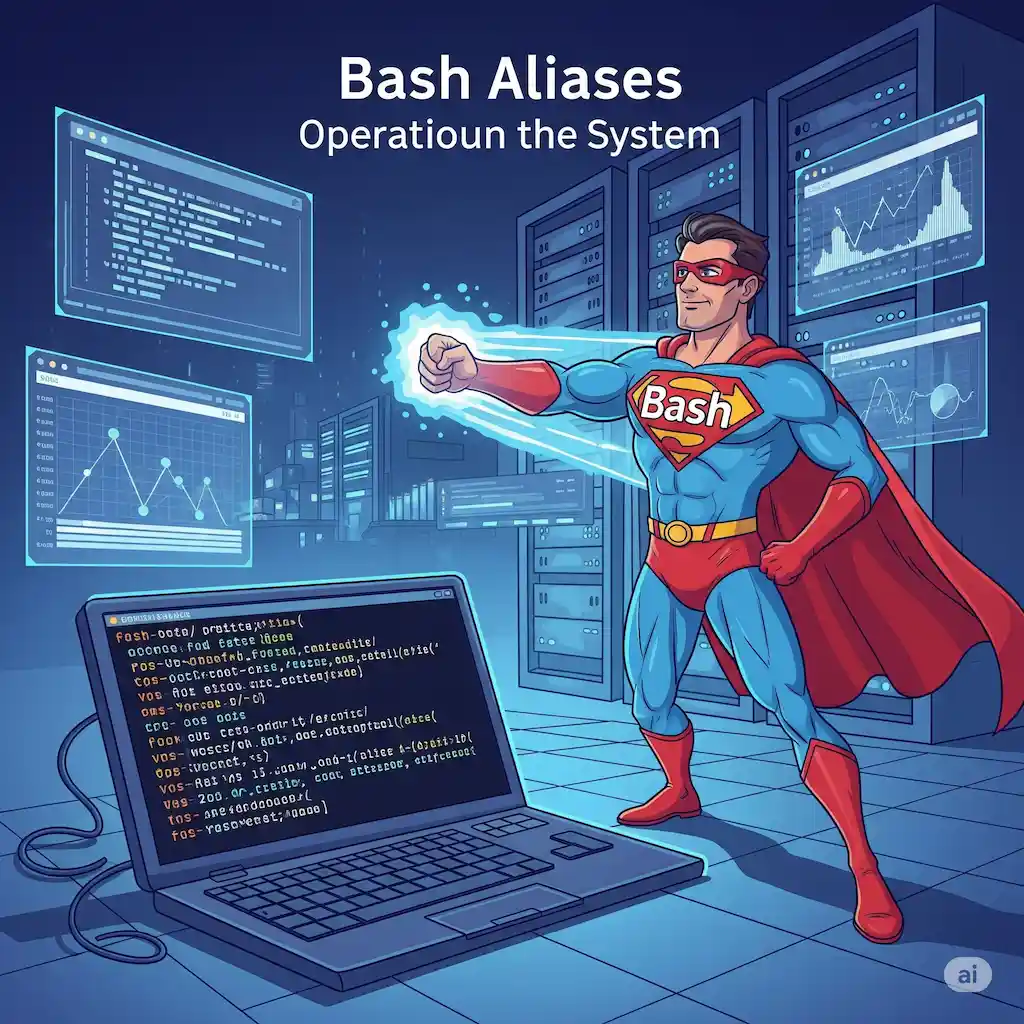Câu Lệnh DevOps và Bash Aliases sẽ giúp bạn cải thiện đáng kể tốc độ khi thao tác. Bạn biết vì sao không?
Tôi Đã Nhìn Một Senior Developer Gõ Một Lệnh. Nó Đã Thay Đổi Quan Điểm Của Tôi.
Vào tuần trước, tôi có nhờ anh Zai DevOps Leader hỗ trợ. Anh ấy cần kiểm tra trạng thái pod, chuyển đổi namespaces, lấy logs và khởi động lại một dịch vụ. Tôi đã mong đợi thấy anh ấy gõ những lệnh Kubernetes dài dòng đó.
Thay vào đó, anh ấy đã gõ: kgp klogs api-pod , krestart api .
Bốn lần gõ phím. Bốn giây. Vấn đề đã được giải quyết.
Anh zai cười bảo tôi. Tao đã không gõ full câu lệnh mấy năm nay rồi 😀
Thì ra là thế =))) cayyy đấy. Vậy thì mình cũng nên clone cái ý tưởng này nhỉ.

Git Shortcuts That Actually Matter
Bash Aliases đầu tiên là với git
# Quick status with colors alias gs='git status -s' # Add everything and commit in one line alias gac='git add . && git commit -m' # Push current branch alias gp='git push origin $(git branch --show-current)' # Pull with rebase (cleaner history) alias gpr='git pull --rebase' # Undo last commit but keep changes alias gundo='git reset --soft HEAD~1' # Show last 10 commits in pretty format alias glog='git log --oneline -10 --graph --decorate' # Delete merged branches alias gclean='git branch --merged | grep -v "\*\|main\|master\|develop" | xargs -n 1 git branch -d' # Quick stash with message alias gstash='git stash push -m' # Show what changed in last commit alias gshow='git show --stat' # Force push safely (checks for updates first) alias gpf='git push --force-with-lease'
Docker Speed One-Liners
Câu Lệnh DevOps thì không thể thiếu docker rồi. Đây là Bash Aliases tôi dùng.
# Stop all containers
alias dstop='docker stop $(docker ps -q)'
# Remove all containers
alias drm='docker rm $(docker ps -aq)'
# Remove all images
alias drmi='docker rmi $(docker images -q)'
# Clean everything (careful with this one!)
alias dclean='docker system prune -af'
# Get into running container quickly
alias dexec='docker exec -it'
# Show container logs with follow
alias dlogs='docker logs -f'
# Quick container stats
alias dstats='docker stats --no-stream'
# Build and run in one command
dbr() { docker build -t $1 . && docker run -it $1; }
# Remove dangling images
alias ddangling='docker rmi $(docker images -f "dangling=true" -q)'
# Quick MySQL container for testing
alias mysql-test='docker run --rm -e MYSQL_ROOT_PASSWORD=root -p 3306:3306 mysql:8'
Kubernetes Shortcuts
Chưa thấy devops nào không dùng k8s :D. đây là Bash Aliases của k8s nhé:
# Short kubectl
alias k='kubectl'
# Get pods with wide output
alias kgp='kubectl get pods -o wide'
# Get all resources
alias kga='kubectl get all'
# Describe pod quickly
alias kdp='kubectl describe pod'
# Get pod logs
alias klogs='kubectl logs -f'
# Delete pod by name
alias kdel='kubectl delete pod'
# Get into pod shell
kexec() { kubectl exec -it $1 -- /bin/bash; }
# Port forward shortcut
kpf() { kubectl port-forward $1 $2:$2; }
# Get services
alias kgs='kubectl get svc'
# Apply and show what changed
alias kapp='kubectl apply -f'
# Get nodes with more info
alias kgn='kubectl get nodes -o wide'
# Switch namespace quickly
kns() { kubectl config set-context --current --namespace=$1; }
# Get current context
alias kctx='kubectl config current-context'
# Top pods (resource usage)
alias ktop='kubectl top pods'
# Get all pods in all namespaces
alias kgpall='kubectl get pods --all-namespaces'
AWS CLI
Trong bộ các câu lệnh devops thì thằng aws cli này là thằng tôi nói luôn là tôi không bao giờ nhớ. Bash aliases thiết lập ban đầu gần như tiết kiệm được 90%.
# List all S3 buckets
alias s3ls='aws s3 ls'
# Sync folder to S3 (upload)
s3up() { aws s3 sync $1 s3://$2 --delete; }
# Download from S3
s3down() { aws s3 sync s3://$1 $2; }
# List EC2 instances with key info
alias ec2ls='aws ec2 describe-instances --query "Reservations[*].Instances[*].[InstanceId,State.Name,InstanceType,PublicIpAddress]" --output table'
# Get AWS account ID
alias awsid='aws sts get-caller-identity --query Account --output text'
# List all regions
alias awsregions='aws ec2 describe-regions --query "Regions[*].RegionName" --output text'
# Quick CloudFormation stack status
cfstatus() { aws cloudformation describe-stacks --stack-name $1 --query 'Stacks[0].StackStatus' --output text; }
# List Lambda functions
alias lambdals='aws lambda list-functions --query "Functions[*].[FunctionName,Runtime]" --output table'
# Get RDS instances
alias rdsls='aws rds describe-db-instances --query "DBInstances[*].[DBInstanceIdentifier,DBInstanceStatus,Engine]" --output table'
Azure CLI Power Moves
# List all resource groups
alias azrg='az group list -o table'
# List VMs with status
alias azvm='az vm list -d -o table'
# Get subscription info
alias azsub='az account show'
# List all locations
alias azloc='az account list-locations -o table'
# Create resource group quickly
azrgcreate() { az group create --name $1 --location $2; }
# Delete resource group (be careful!)
azrgdel() { az group delete --name $1 --yes --no-wait; }
# List storage accounts
alias azst='az storage account list -o table'
# Get AKS credentials
azaks() { az aks get-credentials --resource-group $1 --name $2; }
# List app services
alias azapp='az webapp list -o table'
System Monitoring Made Simple
Máy chủ của bạn đang chạy chậm. Thay vì chạy nhiều lệnh để kiểm tra CPU, bộ nhớ và mức sử dụng đĩa, bạn nhanh chóng gõ mem , df và cpu để có cái nhìn tổng quát.
# Show disk usage in human format
alias df='df -h'
# Show directory sizes
alias du='du -sh *'
# Show memory usage clearly
alias mem='free -h'
# Show top 10 largest files
alias big='du -a | sort -nr | head -10'
# Show listening ports
alias ports='netstat -tuln'
# Show process tree
alias pstree='ps auxf'
# Kill process by name
killp() { pkill -f $1; }
# Show CPU info
alias cpu='lscpu'
# Show system info
alias sysinfo='uname -a && uptime'
# Monitor log files
alias tailf='tail -f'
# Show open files by process
lsofp() { lsof -p $1; }
# Find files larger than size
findbig() { find . -size +$1 -type f -exec ls -lh {} \; | awk '{ print $9 ": " $5 }'; }
File Operations
# Make directory and cd into it
mkcd() { mkdir -p $1 && cd $1; }
# Go back multiple directories
alias ..='cd ..'
alias ...='cd ../..'
alias ....='cd ../../..'
# List files with details
alias ll='ls -alF'
alias la='ls -A'
# Find files by name (case insensitive)
findf() { find . -iname "*$1*"; }
# Find and replace in files
findreplace() { grep -rl "$1" . | xargs sed -i "s/$1/$2/g"; }
# Archive and compress
alias tarzip='tar -czf'
# Extract any archive
extract() {
if [ -f $1 ] ; then
case $1 in
*.tar.bz2) tar xjf $1 ;;
*.tar.gz) tar xzf $1 ;;
*.bz2) bunzip2 $1 ;;
*.rar) unrar e $1 ;;
*.gz) gunzip $1 ;;
*.tar) tar xf $1 ;;
*.tbz2) tar xjf $1 ;;
*.tgz) tar xzf $1 ;;
*.zip) unzip $1 ;;
*.Z) uncompress $1 ;;
*.7z) 7z x $1 ;;
*) echo "'$1' cannot be extracted via extract()" ;;
esac
else
echo "'$1' is not a valid file"
fi
}
Network Debugging Essentials
# Quick ping test
alias pg='ping google.com'
# Show external IP
alias myip='curl -s https://ifconfig.me'
# Show local network info
alias localip='hostname -I'
# Test if port is open
testport() { nc -zv $1 $2; }
# Download file quickly
alias wget='wget -c'
# Speed test
alias speedtest='curl -s https://raw.githubusercontent.com/sivel/speedtest-cli/master/speedtest.py | python -'
# Show network connections
alias netcon='ss -tuln'
# Flush DNS (macOS)
alias flushdns='sudo dscacheutil -flushcache'
# Show routing table
alias route='netstat -rn'
Search and Replace
# Find text in files
findtext() { grep -r "$1" .; }
# Find and count occurrences
counttext() { grep -r "$1" . | wc -l; }
# Case insensitive search
findtexti() { grep -ri "$1" .; }
# Search in specific file types
findpy() { find . -name "*.py" -exec grep -l "$1" {} \;; }
# Replace text in all files
replaceall() { find . -type f -exec sed -i "s/$1/$2/g" {} +; }
# Search command history
alias h='history | grep'
# Search processes
psg() { ps aux | grep $1 | grep -v grep; }
Development Shortcuts
# Start simple HTTP server
alias serve='python3 -m http.server 8000'
# Generate random password
genpass() { openssl rand -base64 ${1:-12}; }
# JSON pretty print
alias json='python3 -m json.tool'
# Base64 encode/decode
alias b64encode='base64'
alias b64decode='base64 -d'
# URL encode
urlencode() { python3 -c "import urllib.parse; print(urllib.parse.quote('$1'))"; }
# Check if website is up
isup() { curl -Is $1 | head -1; }
# Show certificate info
certinfo() { openssl s_client -connect $1:443 </dev/null 2>/dev/null | openssl x509 -noout -dates; }
# Quick note taking
note() { echo "$1" >> ~/notes.txt; }
Pro Tips for Maximum Efficiency
1. Keep aliases organized
# Create ~/.bash_aliases for better organization
touch ~/.bash_aliases
# Add this to your ~/.bashrc
if [ -f ~/.bash_aliases ]; then
source ~/.bash_aliases
fi
2. Create project-specific shortcuts: Tôi đã học điều này khi làm việc trên một dự án React, nơi tôi đã gõ cùng một lệnh npm 50 lần mỗi ngày.
# In your project folder, create .bash_project alias start='npm start' alias test='npm test' alias build='npm run build' alias deploy='npm run build && aws s3 sync build/ s3://my-bucket'
3. Use functions for complex workflows:
# Complete deployment function
deploy() {
echo "Starting deployment..."
git add . &&
git commit -m "Deploy: $(date)" &&
git push origin main &&
kubectl apply -f k8s/ &&
echo "✅ Deployed successfully at $(date)"
}
Bonus: One-Liners That Will Blow Your Mind
# Monitor file changes
watch -n 1 'ls -la'
# Show biggest directories
du -h --max-depth=1 | sort -hr
# Find broken symlinks
find . -type l ! -exec test -e {} \; -print
# Get weather
curl wttr.in/YourCity
# Generate QR code
echo "Your text" | curl -F-=\<- qrenco.de
# Share files instantly
python3 -m http.server 8000
# Backup with timestamp
cp file.txt "file-$(date +%Y%m%d_%H%M%S).txt"
# Find largest files in current directory
find . -type f -printf '%s %p\n' | sort -nr | head -10
# Monitor bandwidth usage
iftop -i eth0
# Convert video to GIF
ffmpeg -i input.mp4 -vf "fps=10,scale=320:-1" output.gif
Lời Cảnh Báo 🚨
Trước khi bạn go alias-crazy:
- Test aliases in a safe environment first
- Some commands can be destructive (especially Docker cleanup ones)
- Always backup important data before using cleanup commands
- The
rmanddocker system prunecommands can’t be undone
Your Next Steps
Các bước thiết lập. Nhiều khi đã đưa hàng cho ae rồi nhưng ae vẫn còn chưa biết thiết lập là hơi dở rồi.
Step 1: Find Your Shell Config File
# Check which shell you're using echo $SHELL # For bash users nano or vi ~/.bashrc # For zsh users (Mac default) nano or vi ~/.zshrc
Step 2: Add Your Favorite Aliases
# Add these to the end of your ~/.bashrc or ~/.zshrc # Git shortcuts alias gs='git status -s' alias gac='git add . && git commit -m' alias gp='git push origin $(git branch --show-current)' # Docker shortcuts alias dstop='docker stop $(docker ps -q)' alias dclean='docker system prune -af' # Kubernetes shortcuts alias k='kubectl' alias kgp='kubectl get pods -o wide'
Step 3: Reload Your Shell
# Apply changes immediately source ~/.bashrc # OR source ~/.zshrc
Step 4: Test Your New Powers
Kinh nghiệm sử dụng
Câu Lệnh DevOps và Bash Aliases dùng sau 1 tháng là bạn thấy rõ sự khác biệt nhé. Tuy nhiên có một số lưu ý mà tôi đã gặp phải để bạn tránh nha.
- Mistake #1: cố gắng ghi nhớ tất cả 50 alias một lần. Không ăn được đâu. Nhớ 5 cái cần nhất trước, hay dùng cái nào thì nhớ. Dần dẫn sẽ tự động tăng thêm.
- Mistake #2: Tôi đã chạy
dclean(docker system prune) mà không suy nghĩ và mất toàn bộ cơ sở dữ liệu phát triển của mình. Phải xây dựng lại mọi thứ từ đầu. Phải hiểu câu lệnh thì mới chạy nha. - Mistake #3: Tôi đã tạo alias với những cái tên gây nhầm lẫn như
dkrclnallvàk8sgetpods. Tôi không thể nhớ chúng làm gì. Tốt nhất là tạo tên alias theo cách riêng của bản thân và ngắn gọn.





[…] 50+ Câu Lệnh DevOps và Bash Aliases sử dụng hàng ngày […]